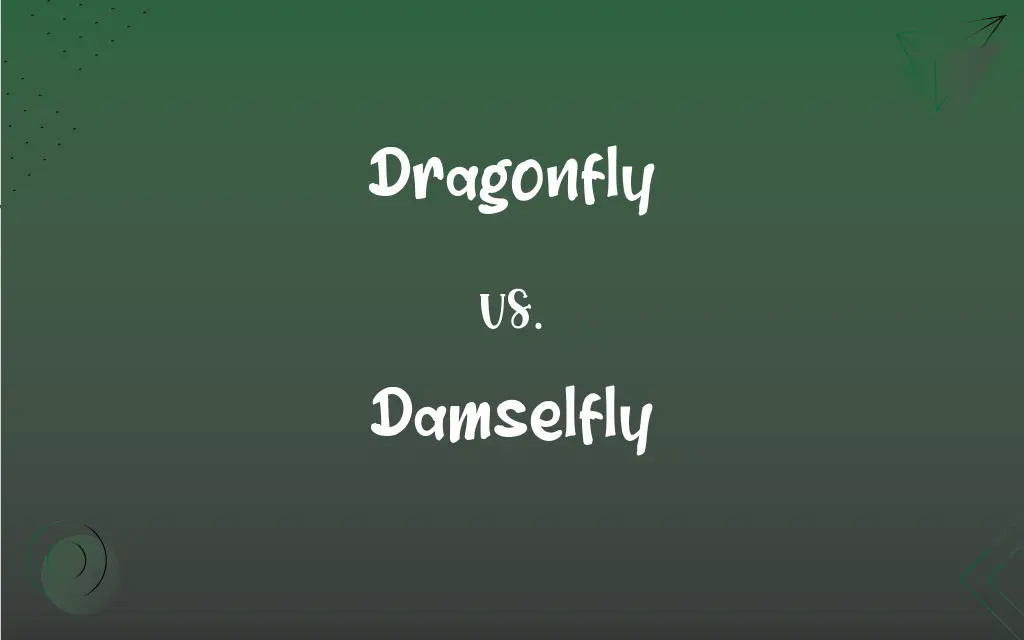Dragonfly vs. Damselfly: What's the Difference?
Edited by Harlon Moss || By Janet White || Published on October 15, 2023
Dragonflies have robust bodies and rest with wings open, while damselflies have slender bodies and rest with wings closed.

Key Differences
Dragonflies are insects that belong to the order Odonata and are characterized by large multifaceted eyes and two pairs of strong transparent wings. Damselflies are also part of the order Odonata but are distinct due to their slimmer bodies and different wing structures, which are usually held closed over the body when at rest.
The eyes of a dragonfly are large and usually touch each other, or nearly so, at the top of the head, providing them with excellent vision. In contrast, the eyes of a damselfly are well separated on each side of the head, making them more prominent and widely spaced.
When it comes to flight, dragonflies are generally stronger fliers with a more robust body, enabling them to hover and even fly backward. Damselflies, with their slender bodies, are typically weaker fliers, and they tend to stay close to the ground and water surfaces.
Dragonflies typically have a broader build, and their hindwing is broader at the base than the forewing. Conversely, damselflies have wings that are typically the same shape and size and are more narrow at the base, making their overall appearance more delicate.
Both dragonflies and damselflies are vital components of their ecosystems, serving as predators of smaller insects, thus controlling mosquito populations. However, damselflies are generally less aggressive and have a softer, more elegant demeanor compared to the more robust and agile dragonflies.
ADVERTISEMENT
Comparison Chart
Body Structure
Robust and broader body.
Slender and more delicate body.
Wing Position
Rests with wings open, perpendicular to the body.
Rests with wings closed, typically over or along the body.
Eye Structure
Eyes are large and usually touch each other.
Eyes are well separated on each side of the head.
Flight Capability
Stronger fliers, can hover and fly backward.
Weaker fliers, stay close to the ground and water surfaces.
Hindwing Shape
Hindwing is broader at the base than the forewing.
Hindwing and forewing are typically the same shape.
ADVERTISEMENT
Dragonfly and Damselfly Definitions
Dragonfly
An insect characterized by large multifaceted eyes and two pairs of strong transparent wings.
The dragonfly hovered effortlessly over the pond.
Damselfly
A beneficial predatory insect with a softer and less aggressive demeanor.
The damselfly, with its gentle appearance, silently contributed to maintaining ecological balance.
Dragonfly
A robust-bodied insect belonging to the order Odonata.
The dragonfly is known for its agility and speed in flight.
Damselfly
An insect with well-separated eyes and generally more delicate in appearance compared to dragonflies.
The damselfly’s separated eyes and slender body distinguish it from its robust cousin.
Dragonfly
An insect with an elongated body and a generally broad hindwing.
The dragonfly can be easily distinguished by its distinctive wing shape.
Damselfly
A slender-bodied insect of the order Odonata, usually holding the wings closed when at rest.
The damselfly rested delicately on the leaf with its wings neatly closed.
Dragonfly
A predatory insect that controls the population of smaller insects like mosquitoes.
The presence of the dragonfly is beneficial in reducing mosquito-related diseases.
Damselfly
A weaker flier that typically stays close to the ground and water surfaces.
The damselfly fluttered weakly near the water’s edge, barely lifting above the reeds.
Dragonfly
An agile flier capable of hovering and flying in multiple directions.
The dragonfly darted back and forth, showcasing its impressive flying skills.
Damselfly
An insect with wings that are typically narrow at the base and similar in size and shape.
The damselfly’s symmetric and narrow wings highlighted its elegant and delicate structure.
Dragonfly
Any of numerous predatory insects of the order Odonata, having large eyes, a long slender body, and two pairs of transparent veined wings, especially those of the order Anisoptera, which hold the wings outstretched when at rest, as distinguished from the damselflies. Also called regionally darner, darning needle, devil's darning needle, mosquito fly, mosquito hawk, needle, skeeter hawk, snake doctor, snake feeder, spindle.
Damselfly
Any of numerous often brightly colored, predatory odonate insects of the suborder Zygoptera that have a long slender body with transparent veined wings and that, unlike dragonflies, hold the wings together over the abdomen when at rest. Also called demoiselle.
Dragonfly
An insect of the suborder Epiprocta or, more strictly, the infraorder Anisoptera, having four long transparent wings held perpendicular to a long body when perched.
Damselfly
Any of various insects of the suborder Zygoptera that have long slender bodies, and are similar to dragonflies but having wings folded when at rest.
Dragonfly
Slender-bodied non-stinging insect having iridescent wings that are outspread at rest; adults and nymphs feed on mosquitoes etc.
Damselfly
A slender nonstinging insect similar to but smaller than the dragonfly but having wings folded when at rest.
Damselfly
Slender non-stinging insect similar to but smaller than the dragonfly but having wings folded when at rest
FAQs
How do Dragonflies rest their wings?
Dragonflies rest with their wings open, perpendicular to their bodies.
How do Damselflies rest their wings?
Damselflies rest with their wings closed over or along their bodies.
Do Dragonflies have larger eyes than Damselflies?
Yes, dragonflies have larger eyes that usually touch each other at the top of the head.
Are the hindwings of Damselflies the same shape as their forewings?
Typically, yes. Damselflies have hindwings and forewings that are similar in shape.
Do Dragonflies have broader hindwings compared to their forewings?
Yes, the hindwings of dragonflies are usually broader at the base than their forewings.
Do Damselflies have slender bodies?
Yes, damselflies have slender and more delicate bodies.
Do Damselflies have a softer demeanor?
Yes, damselflies have a softer, more elegant demeanor.
Are Dragonflies and Damselflies from the same order?
Yes, they both belong to the order Odonata.
Do Dragonflies have robust bodies?
Yes, dragonflies have a more robust and broader body structure compared to damselflies.
Are Dragonflies and Damselflies colorful?
Yes, both dragonflies and damselflies can exhibit vibrant and diverse colorations.
Are Damselflies weaker fliers compared to Dragonflies?
Yes, damselflies are generally weaker fliers and tend to stay close to the ground and water surfaces.
Are Dragonflies and Damselflies beneficial to ecosystems?
Yes, they both play a crucial role in controlling the population of other smaller insects, such as mosquitoes.
Are Dragonflies aggressive predators?
Yes, dragonflies are more aggressive predators compared to damselflies.
Can Dragonflies hover in flight?
Yes, dragonflies have the ability to hover and even fly backward.
Can Damselflies be easily distinguished from Dragonflies?
Yes, their slender bodies, wing position when at rest, and well-separated eyes help distinguish them from dragonflies.
About Author
Written by
Janet WhiteJanet White has been an esteemed writer and blogger for Difference Wiki. Holding a Master's degree in Science and Medical Journalism from the prestigious Boston University, she has consistently demonstrated her expertise and passion for her field. When she's not immersed in her work, Janet relishes her time exercising, delving into a good book, and cherishing moments with friends and family.
Edited by
Harlon MossHarlon is a seasoned quality moderator and accomplished content writer for Difference Wiki. An alumnus of the prestigious University of California, he earned his degree in Computer Science. Leveraging his academic background, Harlon brings a meticulous and informed perspective to his work, ensuring content accuracy and excellence.






































































